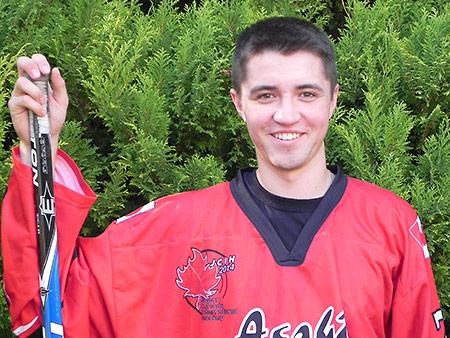Jarred Hawkins travelled with the Asahi Blades midget hockey team to play six games in 10 days in Japan. These were ‘away’ games in more than one way. The players were all Japanese-Canadians learning about Japanese culture and mixing with Japanese youth on and off the ice.
Hawkins, age 17, had not been to Japan since he was four years old. He extended his stay to visit members of his mother’s family and returned to Powell River with a greater understanding of his Japanese heritage. “I learned tons about the culture. It was an incredible experience.”
Hawkins was struck by how respectful everyone is in Japan. “People are kind and respect order. There is no garbage on the street, the traffic is very organized.” On the day Hawkins went to the Golden Temple in Kyoto it was raining and he noticed that even the umbrellas were orderly, half were held up and half down, so that no umbrella touched another. “I think it is a good way to live in a dense population,” says Hawkins.
The Japanese high-school teams played a completely different type of hockey and they usually won over their visitors. “Their players practice every day at school and they work really well as a team.” Hawkins reports. “While Canadian teams tend to have one or two stand out players, in Japan it is about team playing. They pass faster. And the top ranking teams have practices every day of the year.” In contrast the Asahi Blades were together for weekend practices in July before they travelled, and for some of the Canadians it was their first time playing on the wider international ice rink. Hawkins and his teammates did not let their handicaps bother them. “I was having fun regardless of the score.” Hawkins says. And they did win the last game.
As Hawkins points out, it is not about the score at all. Japan-Canada International Hockey Program [JCIHP] uses ice hockey as a conduit for introducing young Japanese Canadians to the country of their heritage. Site seeing, meeting people, and participating in cultural events were important parts of the journey.
The Asahi Blades visited high-schools in Tokyo and Kushiro, where they were taught Taiko Drumming and Kendo sword arts as well as how to make and pour tea. During the tea ceremony the team found it awkward to sit Japanese style while answering questions from the female students about their girlfriends.
For most of the time the team resided in a bath house in the city of Kushiro. They washed in the traditional way with shower stations and hot tubs, along with local people. They slept on traditional sleeping mats. Each Canadian player also experienced a home-stay night with a Japanese family.
In Kushiro, the Blades were invited to carry the mikoshi (shrine) in the Kin (Mist) Festival. They were dressed in traditional Happi coats, two-toed socks, and wooden shoes. The Happi coats were a bit too short for them, which reportedly made some girls happy. The players enjoyed almost celebrity status among the Japanese students which they received with aplomb. They were described as the most polite, entertaining, and best behaved team to date; certain praise in a country that values respect.
JCIHP depends on donations and fund raising to help cover trip expenses and the Hawkins family really appreciates the sponsors that helped to fund Jarred’s trip. RONA donated a silent auction item to the fund raising banquet and local people attended the banquet and bought raffle tickets. Breakers Marine in Port Alberni also donated to the cause.
Since its beginning in 2000, the hockey exchange has kindled an interest in Japan for young Japanese-Canadian hockey players. Many return to Japan for work, recreation, or study. Hawkins is sure to be in that number. He is impressed by the county of his heritage and has a deeper understanding of the culture there. He says he will definitely go to Japan again.



